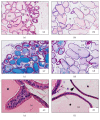Ginger Ingredients Alleviate Diabetic Prostatic Complications: Effect on Oxidative Stress and Fibrosis
- PMID: 28904557
- PMCID: PMC5585679
- DOI: 10.1155/2017/6090269
Ginger Ingredients Alleviate Diabetic Prostatic Complications: Effect on Oxidative Stress and Fibrosis
Abstract
Prostatic complications are common in patients with diabetes. This study investigated the effect of different ginger ingredients: zingerone, geraniol, and 6-gingerol on the prostate in diabetic rats. Diabetes was induced in Wistar rats by streptozotocin intraperitoneal injection (50 mg/kg), and the rats were left for 10 weeks to develop prostatic complications. In diabetic treated groups, rats received daily oral zingerone, geraniol, and 6-gingerol in doses of 20, 200, and 75 mg/kg, respectively, in the last 8 weeks. Treatment with the compounds caused changes in the ventral prostate of diabetic animals as indicated by the columnar ductal epithelium and dense secretions. There was an amelioration of oxidative stress as evidenced by the lowering of prostate malondialdehyde and elevating prostate oxidized to reduced glutathione (GSH/GSSG) ratios by geraniol and 6-gingerol. None of the three ginger ingredients affected the hyperglycemia, reduction in body weight gain, and testosterone deficiency seen in diabetic animals. Interleukin-1β and interleukin-6 levels remained unchanged. However, zingerone and geraniol ameliorated the fibrosis in diabetic prostate through suppressing the elevated prostate transforming growth factor beta 1 (TGFβ1) and collagen IV. Therefore, ginger ingredients could be beneficial in alleviating diabetic prostatic complications through suppressing oxidative stress and tissue fibrosis.
Figures










Similar articles
-
Protective effects of zingerone on oxidative stress and inflammation in cisplatin-induced rat nephrotoxicity.Biomed Pharmacother. 2018 Sep;105:225-232. doi: 10.1016/j.biopha.2018.05.085. Epub 2018 May 30. Biomed Pharmacother. 2018. PMID: 29857302
-
Geraniol alleviates diabetic cardiac complications: Effect on cardiac ischemia and oxidative stress.Biomed Pharmacother. 2017 Apr;88:1025-1030. doi: 10.1016/j.biopha.2017.01.131. Epub 2017 Feb 6. Biomed Pharmacother. 2017. PMID: 28178614
-
Centaurium erythraea methanol extract protects red blood cells from oxidative damage in streptozotocin-induced diabetic rats.J Ethnopharmacol. 2017 Apr 18;202:172-183. doi: 10.1016/j.jep.2017.03.016. Epub 2017 Mar 16. J Ethnopharmacol. 2017. PMID: 28323046
-
Zingerone alleviates the delayed ventricular repolarization and AV conduction in diabetes: Effect on cardiac fibrosis and inflammation.PLoS One. 2017 Dec 5;12(12):e0189074. doi: 10.1371/journal.pone.0189074. eCollection 2017. PLoS One. 2017. PMID: 29206854 Free PMC article.
-
Protective effects of Quercetin and chronic moderate exercise (training) against oxidative stress in the liver tissue of streptozotocin-induced diabetic rats.Physiol Int. 2016 Mar;103(1):49-64. doi: 10.1556/036.103.2016.1.5. Physiol Int. 2016. PMID: 27030627
Cited by
-
Nanoparticles of Costus speciosus Ameliorate Diabetes-Induced Structural Changes in Rat Prostate through Mediating the Pro-Inflammatory Cytokines IL 6, IL1β and TNF-α.Molecules. 2022 Feb 2;27(3):1027. doi: 10.3390/molecules27031027. Molecules. 2022. PMID: 35164292 Free PMC article.
-
Regulation of Neuropeptide Y Receptor Gene Expression and Hormone Level in Obese Male Rats Receiving 6-Gingerol and L-Arginine Supplementation.Arch Razi Inst. 2024 Feb 1;79(1):180-188. doi: 10.32592/ARI.2024.79.1.180. eCollection 2024 Feb. Arch Razi Inst. 2024. PMID: 39192952 Free PMC article.
-
Ginger and Testosterone.Biomolecules. 2018 Oct 22;8(4):119. doi: 10.3390/biom8040119. Biomolecules. 2018. PMID: 30360442 Free PMC article. Review.
-
6-Paradol Alleviates Testosterone-Induced Benign Prostatic Hyperplasia in Rats by Inhibiting AKT/mTOR Axis.Plants (Basel). 2022 Oct 3;11(19):2602. doi: 10.3390/plants11192602. Plants (Basel). 2022. PMID: 36235468 Free PMC article.
-
Nutritional aphrodisiacs: Biochemistry and Pharmacology.Curr Res Food Sci. 2024 Jun 11;9:100783. doi: 10.1016/j.crfs.2024.100783. eCollection 2024. Curr Res Food Sci. 2024. PMID: 38974844 Free PMC article. Review.
References
LinkOut - more resources
Full Text Sources
Other Literature Sources

